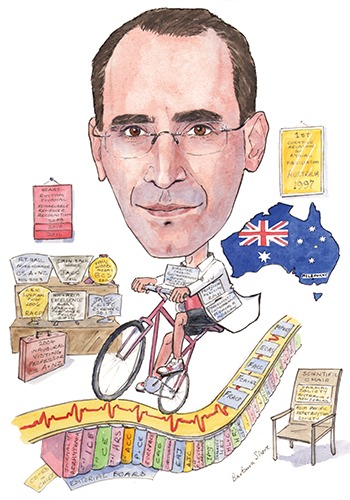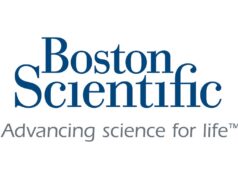 A leading heart rhythm expert in Australia, Jonathan M Kalman directs both clinical and research groups in the Department of Cardiac Arrhythmias at the Royal Melbourne Hospital and University of Melbourne, Australia. He performed the first curative ablation procedure for atrial fibrillation in Australia in 1997, has authored over 250 peer-reviewed publications and more than 30 book chapters, delivered over 200 invited lectures at national and international meetings and has won several awards. In this interview, he recalls details of that first ablation procedure and talks about the impact of lifestyle modification in atrial fibrillation management and the most interesting innovations in electrophysiology on the horizon. As the current scientific chair of the Cardiac Society of Australia and New Zealand, and of the Asia Pacific Heart Rhythm Society (APHRS), he speaks about electrophysiology practice in this region.
A leading heart rhythm expert in Australia, Jonathan M Kalman directs both clinical and research groups in the Department of Cardiac Arrhythmias at the Royal Melbourne Hospital and University of Melbourne, Australia. He performed the first curative ablation procedure for atrial fibrillation in Australia in 1997, has authored over 250 peer-reviewed publications and more than 30 book chapters, delivered over 200 invited lectures at national and international meetings and has won several awards. In this interview, he recalls details of that first ablation procedure and talks about the impact of lifestyle modification in atrial fibrillation management and the most interesting innovations in electrophysiology on the horizon. As the current scientific chair of the Cardiac Society of Australia and New Zealand, and of the Asia Pacific Heart Rhythm Society (APHRS), he speaks about electrophysiology practice in this region.
What drew you to medicine and particularly electrophysiology?
I went into medicine, probably too young, to make an informed decision and fortuitously it has become a life-long passion. I loved physiology in medical school and so was naturally drawn to cardiology and in particular the analytic aspects of electrophysiology. The field of electrophysiology was really in its infancy at that time and I have been fortunate that my career has encompassed the dramatic evolution of curative interventions for virtually the full spectrum of arrhythmias.
Who were your mentors and what did you learn from them?
I have had many mentors over a career spanning now three decades. Without question, my years in San Francisco (1993-1996) were transformative for my career. From Michael Lesh, I developed an infectious enthusiasm for interventional electrophysiology and for research into arrhythmia mechanisms. From Mel Scheinman, I also developed a passion for the detail of electrophysiology. Mel’s “reading the rolls” sessions (studying the electrophysiology cases albeit now on computer rather than rolls of paper!) still stand me in good stead during complex and difficult cases. Twenty years on, Mel continues nurturing my career.
What is your biggest motivation for working in medicine?
Perhaps the biggest thrill after all of these years is still to hear from patients that you have given them back their quality of life. It is certainly a field of medicine where we can make a dramatic difference in patients’ lives. I also love the interaction with colleagues at international and national levels and the enjoyment of teaching the many fellows who have come through the department.
You performed the first curative ablation procedure for atrial fibrillation in Australia; could you recall this procedure and what did it mean –for you?
I recall the patient very well. She was a young woman in her 30s with a focally mediated atrial fibrillation originating in the left superior pulmonary vein. At that time, we had begun using the Haïssaguerre approach of chasing triggers inside the pulmonary vein sleeves (even before it was published a year later in the New England Journal of Medicine). I saw her again recently and she continues doing well, now 18 years down the track, which is most unusual for those early procedures. The procedure has evolved considerably since then! This ablation raised for the first time in Australia the possibility that we may be able to offer atrial fibrillation patients something more than ineffective drugs.
Could you describe another memorable case that you treated –and why you remember it?
The first patient I treated with 3D mapping (Carto, Biosense Webster) was a patient with complex atrial flutter circuits in the left atrium. The dramatic new images of electrophysiologic activation superimposed on anatomy allowed us to demonstrate the two different tachycardia loops and facilitated curative ablation of the circuits. Almost 20 years later, this patient still sends me a gift for Christmas.
In your view what are the most interesting innovations in electrophysiology currently –on the horizon, but not yet in clinical practice?
The evolution of techniques to cure more patients with atrial fibrillation and to be able to personalise and tailor the procedure will be the most interesting advance in electrophysiology. Whether this will be by substrate mapping or mapping of rotors or foci I think remains to be seen.
You have dedicated a great proportion of your career to research, have been an award-winning researcher and have also mentored a good number of PhD students with award-winning investigations; in your view what are the set of skills needed to excel in medical research?
Some of the key factors required to excel in medical research are obviously a passion for it and also the ability to construct an outstanding team of contributors. Often the best ideas are borne of discussions with colleagues and collaborators.
Could you give us a summary of the highlights of the 8th Asia Pacific Heart Rhythm Society (APHRS) Scientific Sessions (Melbourne, Australia, 19-22 November 2015)?
We had an outstanding international and regional faculty who really made the meeting a success. We were extremely fortunate that so many of the top people in our field made the long trip to Melbourne. We had almost 2,500 delegates from 42 countries. From the many different sessions that could be highlighted I could mention our named lecturers: Dr David Ross from Westmead in Sydney who gave a beautiful tour through AV node re-entry, including much of his department’s ground-breaking work; and Dr Mel Scheinman from UCSF Medical Center in San Francisco who gave an insightful view of the history, the present and the future of electrophysiology. Mel characteristically downplayed his own immense contributions.
In your view what are the main differences of electrophysiology practice in the Asia Pacific region compared with Europe –and North America?
Asia Pacific is an extremely diverse region with countries ranging from well-funded and well-resourced healthcare systems to those with very rudimentary resources and limited available technology. One of the goals of APHRS is to elevate the level of knowledge and the practice of arrhythmia management across the region. Of course in Europe and North America, there is a much more uniform practice of advanced arrhythmia management with access to cutting edge technologies.
As scientific chairman of the Cardiac Society of Australia and New Zealand, could you tell us what are the key advances of cardiology in –this area?
We continue to see the dramatic impact of new device technologies in cardiology. Whether these be for valve replacement, closure of congenital heart defects, sub-cutaneous defibrillation, leadless pacing, rapid high-density mapping of the heart-to name but few-the progress we have seen would have been unimaginable when I was training 25 years ago. Similarly, the advent of genetics in cardiology has opened an entirely new understanding of many cardiac conditions and paved the way for the possibility of gene therapy.
What is needed to improve the delivery of cardiac care in Australia and New Zealand?
I think we are fortunate to have a very high level of cardiac care in the region. However, we would benefit greatly from more funding for research and innovation. One of the challenges of a geographically very large country like Australia is to provide high-quality care to remote regions and indigenous populations.
What are your interests outside of medicine?
I am blessed with a beautiful wife and three daughters who I love to spend time with. I am a keen cyclist and enjoy the challenge of a mountain climb.
Fact File
Current appointments
2014- National Health and Medical Research Council (NHMRC) of -Australia practitioner fellow
2012- Scientific chairman, Cardiac Society of Australia and New Zealand
2012- Scientific chairman, Asia Pacific Heart Rhythm Society
2002- Professor of Medicine, Department of Medicine, University of Melbourne
2002- Director of Cardiac Electrophysiology, Royal Melbourne Hospital, Melbourne, Australia
Qualifications
1983 MBBS – University of Melbourne
1991 FRACP – (Fellow of the Royal Australasian College of Physicians)
1994 PhD – University of Melbourne (Interactive aspects of sinus node function and atrial fibrillation)
Most recent peer-reviewed –scholarships and awards
2015 Paul Wood Medal of the British Cardiovascular Society
2014 NHMRC Research excellence award for nationally highest ranked practitioner fellowship
2014 Simon Dack Award of the Journal of the American College of Cardiology (for outstanding scholarship and service to the Journal)
2012 Journal of the American College of Cardiology, Elite Reviewer Award
2009, 2010, 2011 HeartRhythm Journal Remarkable Reviewer Recognition
Society memberships
Fellow of the Royal Australasian College of Physicians
Fellow of the Cardiac Society of Australia and New Zealand
Fellow of the Heart Rhythm Society
Fellow of the American College of Cardiology
European Cardiac Arrhythmia Society
Fellow Asia Pacific Heart Rhythm Society









